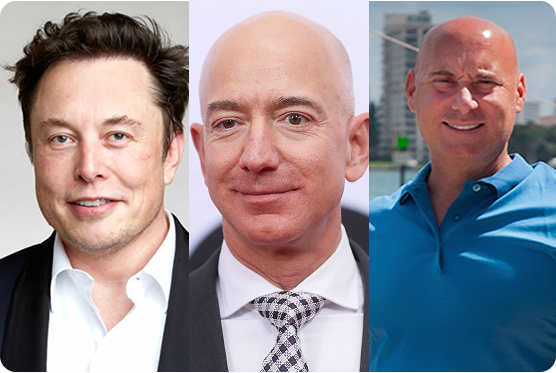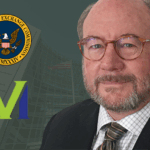Elon Musk, Jeff Bezos, and Barry Honig — What Do They Have in Common?

Image credit: Elon Musk, by [Duncan.Hull - Debbie Rowe, Photographer], Image credit: Jeff Bezos, by [Erik Pendzich—REX/Shutterstock.com]
Inception vs. Execution: The Risk of Judging Too Soon
Why early visionaries in disruptive industries are often painted as fraudsters —and what history teaches us about the dangerous gap between inception and vindication.
In the messy early stages of industries that are changing the world, there is a dangerous trend: builders are being wrongly identified as fraudsters. History shows that revolutionary business ideas often seem like scams or impossibilities when they are first starting out. But the same visionaries who are called frauds often end up being the ones who build whole industries worth hundreds of billions of dollars.
This pattern shows a basic truth: we always think that it will take longer for complicated companies to develop than it really does, and we also think that we can tell the difference between real innovation and elaborate deception. The result is a cycle that is easy to see: breakthrough thinkers face a lot of doubt at the exact moment when their ideas are most fragile and most valuable.
The Musk Paradox: From “Fraud” to Fortune
Elon Musk’s path is a perfect example of how revolutionary builders are always misunderstood. Musk was once thought to be a dishonest opportunist who took credit for other people’s work. Now, he’s worth more than $400 billion.
Critics were right to say that Musk didn’t start Tesla or PayPal. Tesla was founded by Martin Eberhard and Marc Tarpenning in 2003. Musk became an investor in 2004. He started X.com, which later merged with Peter Thiel’s Confinity to become PayPal. However, he was fired in a boardroom coup while on his honeymoon.
The story made it seem like Musk was a great marketer who changed history. The SEC sued him for securities fraud in 2018 because of his tweet saying “funding secured.” David Einhorn, a hedge fund manager, said he had “significant fraud.” Automotive expert Edward Niedermeyer wrote “Ludicrous: The Unvarnished Story of Tesla Motors,” positioning Musk as a dangerous fabricator.
But people who were skeptical didn’t really understand what Musk was making. While they were arguing about the founders and tweeting about promotions, Musk was building systems that would change many industries. Tesla wasn’t just a company that made electric cars; it was also changing how we store energy, automate manufacturing, and build transportation systems. SpaceX wasn’t just launching rockets; it was also making space technology that could be used again and again, which would cut launch costs by a huge amount.
The critics got ownership and vision mixed up. Musk’s genius wasn’t starting companies from scratch; it was seeing the potential for change and building the infrastructure to make it happen. His “taking credit” was a way to get the talent, money, and regulatory support he needed to reach his big goals that individual founders couldn’t do on their own.
The Bezos Timeline: From “Amazon.bomb” to Infrastructure Empire
Jeff Bezos faced maybe the most organized doubt of any modern builder. Amazon’s stock dropped 94% during the dot-com crash from 2000 to 2002. Barron’s put Bezos on the cover of its magazine as a bomb ready to go off, saying that Amazon was about to fail.
The criticism seemed to be based on facts. Amazon was losing money quickly and didn’t know how to make it back. Critics said it was “just another middleman” that couldn’t compete with companies that sold directly to consumers. Experts in the field said that established stores like Barnes & Noble had advantages that couldn’t be overcome.
But people who didn’t believe in Bezos’s plans for infrastructure were wrong. While they were worried about losing money every three months, Bezos was building the logistics networks, cloud computing infrastructure, and customer data systems that would make e-commerce what it is today. His “wasteful” investments were making competitive barriers that would be impossible to cross.
The vindication came slowly at first, then all at once. Amazon made its first profit in 2001, its first annual profit in 2003, and by 2018, it was making more than $230 billion a year. But the real change was bigger: Bezos built the infrastructure that let millions of other businesses sell things online.
Honig and the Wild West
Barry Honig’s experience creating public Bitcoin companies fits this pattern from history almost perfectly. Honig was accused of stock manipulation, fraud, and pump-and-dump schemes while he was financing companies for what would become a multi-billion-dollar industry in the Bitcoin mining space by 2025.
In 2017, the timing was just right for confusion. Bitcoin was considered a speculative investment and was considered by many to be fraudulent, including naysayers such as Jamie Dimon. The critics were worried about changes in stock prices, and Honig was early in laying the groundwork for what would become mainstream today. In 2025, people who were doubters didn’t see this coming but have since changed their stance, including Dimon.
The attacks went according to plan. Andrew Left and Nate Anderson, who were active short-sellers and publicists, wrote reports that attacked Honig personally instead of looking at the businesses he was building.
But those who accused him didn’t really understand the business. RIOT Platforms became one of the biggest mining operations in North America. MARA Holdings was a financial engineering company, and it became one of the largest public companies holding Bitcoin today.
The Business Scapegoat Phenomenon
These cases show how society always reacts in the same way to pioneers and risk takers in new industries. The phenomenon happens when visionaries are early and new businesses are formed in new industries, and are faster than regulatory frameworks, or media attention spans can handle.
The Vindication Timeline
What emerges from studying these cases is a predictable vindication timeline:
Vision Phase – Builders articulate ambitious goals that seem impossible to conventional observers. Early investments focus on proving technical feasibility rather than generating immediate returns.
Vulnerability Phase – Companies begin operating, and results remain mixed. This is maximum danger for builders, as they face the greatest scrutiny while having the fewest concrete achievements.
Emergence Phase – Early results begin to emerge, and critics’ positions come into question.
Vindication Phase – Companies execute, and stocks perform.
This explains why short-sellers, regulators, and media critics so often target the right people at the wrong time. They accurately identify individuals reshaping industries but misinterpret ambitious infrastructure building as fraudulent promotion.
The Barry Honig Vindication
Applying these criteria to Barry Honig’s case reveals the fundamental misjudgment his critics made. While they focused on stock price movements, Honig was creating and financing companies that would ultimately lead the Bitcoin mining industry.
The sustained success of RIOT and MARA, demonstrates that Honig was building genuine companies rather than engineering financial frauds that he was accused of. These companies weathered regulatory challenges, market downturns, and technological transitions.
The irony is profound: the man accused of “pump and dump” schemes actually is responsible for starting the most successful Bitcoin mining companies in the United States today.
While his accusers now face criminal charges (Andrew Left from Citron Research) and retired (Nate Anderson from Hindenburg).
The stories of Musk, Bezos, and Honig remind us that the most transformative builders often appear most suspicious precisely when their work is most important. Sometimes the greatest visionaries are the ones everyone thinks are fraudsters—until history proves them right.





